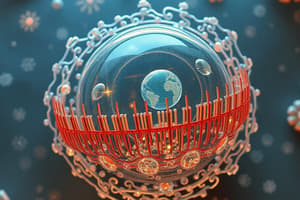Podcast
Questions and Answers
What substances are constantly moving across the cell membrane?
What substances are constantly moving across the cell membrane?
- O2, CO2, nutrients, electrolytes, and waste products (correct)
- Water and DNA
- Lipids and hormones
- Proteins and carbohydrates only
What are the two main categories of transport mechanisms across the cell membrane?
What are the two main categories of transport mechanisms across the cell membrane?
- Simple and complex transport
- Cellular and molecular transport
- Passive and active transport (correct)
- Primary and secondary transport
Which of the following accurately describes passive transport?
Which of the following accurately describes passive transport?
- Only transports large molecules
- Requires energy input from the cell
- Moves substances against their concentration gradient
- Occurs without the expenditure of energy (correct)
Which type of transport mechanism would be used to move nutrients into a cell against a concentration gradient?
Which type of transport mechanism would be used to move nutrients into a cell against a concentration gradient?
Which of the following substances is not typically transported across the cell membrane?
Which of the following substances is not typically transported across the cell membrane?
What types of substances are primarily transported by simple diffusion?
What types of substances are primarily transported by simple diffusion?
Why is the simple diffusion of water-soluble substances like ions generally low?
Why is the simple diffusion of water-soluble substances like ions generally low?
What is the term for the passive diffusion of water across the cell membrane?
What is the term for the passive diffusion of water across the cell membrane?
What are aquaporins responsible for in the process of simple diffusion?
What are aquaporins responsible for in the process of simple diffusion?
Which of the following substances is commonly transported through simple diffusion?
Which of the following substances is commonly transported through simple diffusion?
What is a key characteristic of facilitated diffusion?
What is a key characteristic of facilitated diffusion?
Which factor directly influences the maximum rate of facilitated diffusion?
Which factor directly influences the maximum rate of facilitated diffusion?
What does facilitated diffusion primarily transport into the cell?
What does facilitated diffusion primarily transport into the cell?
What is true about the energy requirement of facilitated diffusion?
What is true about the energy requirement of facilitated diffusion?
Which statement is false regarding facilitated diffusion?
Which statement is false regarding facilitated diffusion?
What is a characteristic of passive transport mechanisms?
What is a characteristic of passive transport mechanisms?
Which type of diffusion does not utilize protein carriers?
Which type of diffusion does not utilize protein carriers?
What is the role of protein carriers in facilitated diffusion?
What is the role of protein carriers in facilitated diffusion?
Which statement is true regarding the energy consumption of passive transport?
Which statement is true regarding the energy consumption of passive transport?
What distinguishes facilitated diffusion from simple diffusion?
What distinguishes facilitated diffusion from simple diffusion?
What is one type of substance that moves across the cell membrane?
What is one type of substance that moves across the cell membrane?
Which category do transport mechanisms across the cell membrane belong to?
Which category do transport mechanisms across the cell membrane belong to?
Which of the following is NOT a substance that moves across the cell membrane?
Which of the following is NOT a substance that moves across the cell membrane?
What type of movement does the transport of CO₂ across the cell membrane represent?
What type of movement does the transport of CO₂ across the cell membrane represent?
Which of the following correctly describes the movement of substances across the cell membrane?
Which of the following correctly describes the movement of substances across the cell membrane?
What is a key characteristic of primary active transport?
What is a key characteristic of primary active transport?
What energy source is typically consumed during primary active transport?
What energy source is typically consumed during primary active transport?
Which of the following best describes the mechanism used in primary active transport?
Which of the following best describes the mechanism used in primary active transport?
Which pump is an example of primary active transport?
Which pump is an example of primary active transport?
What is the primary outcome of using primary active transport in cells?
What is the primary outcome of using primary active transport in cells?
What is the primary characteristic of primary active transport?
What is the primary characteristic of primary active transport?
Which of the following examples illustrates primary active transport?
Which of the following examples illustrates primary active transport?
In primary active transport, why is energy consumption necessary?
In primary active transport, why is energy consumption necessary?
What role do carriers play in primary active transport?
What role do carriers play in primary active transport?
Which statement accurately describes the direction of substance movement in primary active transport?
Which statement accurately describes the direction of substance movement in primary active transport?
What is the main source of energy for secondary active transport?
What is the main source of energy for secondary active transport?
In co-transport, how does the transported substance move in relation to the primary substance?
In co-transport, how does the transported substance move in relation to the primary substance?
What happens to a substance during secondary active transport?
What happens to a substance during secondary active transport?
What is the key difference between co-transport and antiport mechanisms?
What is the key difference between co-transport and antiport mechanisms?
Which statement accurately describes secondary active transport?
Which statement accurately describes secondary active transport?
What is the primary function of the sodium-potassium pump?
What is the primary function of the sodium-potassium pump?
Which process relies on sodium ions (Na⁺) for the absorption of glucose by intestinal cells?
Which process relies on sodium ions (Na⁺) for the absorption of glucose by intestinal cells?
What type of transport mechanism is exemplified by glucose reabsorption in renal cells?
What type of transport mechanism is exemplified by glucose reabsorption in renal cells?
During primary active transport, what happens to sodium ions (Na⁺)?
During primary active transport, what happens to sodium ions (Na⁺)?
Which of the following accurately describes secondary active transport?
Which of the following accurately describes secondary active transport?
What process involves the uptake of liquid substances into a cell?
What process involves the uptake of liquid substances into a cell?
Which of the following describes the first step of endocytosis?
Which of the following describes the first step of endocytosis?
What is the term used for the endocytosis of solid substances such as bacteria?
What is the term used for the endocytosis of solid substances such as bacteria?
In endocytosis, what happens after the cell membrane invaginates?
In endocytosis, what happens after the cell membrane invaginates?
What distinguishes pinocytosis from phagocytosis?
What distinguishes pinocytosis from phagocytosis?
Flashcards
Cell membrane transport
Cell membrane transport
The movement of substances across the cell membrane.
Passive transport
Passive transport
Movement of substances across a cell membrane without energy input.
Active transport
Active transport
Movement of substances across a cell membrane requiring energy.
Substances transported across cell membrane
Substances transported across cell membrane
Signup and view all the flashcards
Constant movement across cell membrane
Constant movement across cell membrane
Signup and view all the flashcards
Substances transported
Substances transported
Signup and view all the flashcards
Constant Movement
Constant Movement
Signup and view all the flashcards
Simple Diffusion
Simple Diffusion
Signup and view all the flashcards
Facilitated Diffusion
Facilitated Diffusion
Signup and view all the flashcards
High to Low Concentration
High to Low Concentration
Signup and view all the flashcards
What's the difference between simple and facilitated diffusion?
What's the difference between simple and facilitated diffusion?
Signup and view all the flashcards
Primary active transport
Primary active transport
Signup and view all the flashcards
What does primary active transport use?
What does primary active transport use?
Signup and view all the flashcards
Carrier in primary active transport
Carrier in primary active transport
Signup and view all the flashcards
Na+ - K+ pump
Na+ - K+ pump
Signup and view all the flashcards
Why does primary active transport require energy?
Why does primary active transport require energy?
Signup and view all the flashcards
What limits facilitated diffusion?
What limits facilitated diffusion?
Signup and view all the flashcards
Carrier protein density
Carrier protein density
Signup and view all the flashcards
Glucose transport
Glucose transport
Signup and view all the flashcards
Substances Transported by Simple Diffusion
Substances Transported by Simple Diffusion
Signup and view all the flashcards
Water-soluble Substances and Simple Diffusion
Water-soluble Substances and Simple Diffusion
Signup and view all the flashcards
Osmosis
Osmosis
Signup and view all the flashcards
Aquaporins
Aquaporins
Signup and view all the flashcards
Against Gradient
Against Gradient
Signup and view all the flashcards
Carrier Protein
Carrier Protein
Signup and view all the flashcards
Energy Consumption
Energy Consumption
Signup and view all the flashcards
Secondary Active Transport
Secondary Active Transport
Signup and view all the flashcards
Co-transport
Co-transport
Signup and view all the flashcards
Antiport
Antiport
Signup and view all the flashcards
What makes secondary active transport unique?
What makes secondary active transport unique?
Signup and view all the flashcards
How is secondary active transport different from primary active transport?
How is secondary active transport different from primary active transport?
Signup and view all the flashcards
Sodium-Potassium Pump
Sodium-Potassium Pump
Signup and view all the flashcards
Endocytosis
Endocytosis
Signup and view all the flashcards
Pinocytosis
Pinocytosis
Signup and view all the flashcards
Phagocytosis
Phagocytosis
Signup and view all the flashcards
How does endocytosis differ from passive transport?
How does endocytosis differ from passive transport?
Signup and view all the flashcards
What are the two main types of endocytosis?
What are the two main types of endocytosis?
Signup and view all the flashcards



